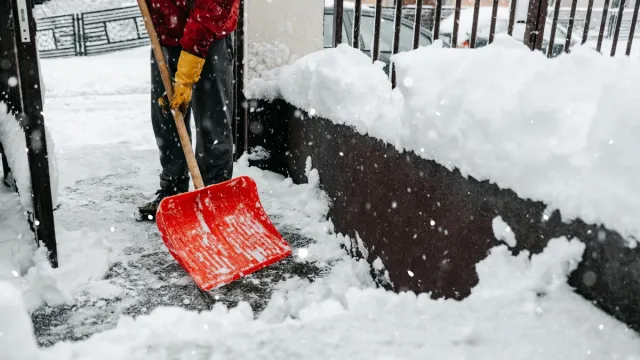Pre-Valentine’s Day Storm Could Bring Up to 12 Inches of Snow to These Areas

Love may not be the only thing in the air next week. While Punxsutawney Phil has predicted an early spring for the U.S., winter is not yet over, and the threat of more snow is looming. In a Feb. 7 report, AccuWeather meteorologists revealed that they’re monitoring a winter storm that’s expected to hit early next week after days of unusual warmth. Where and how much snow the storm is set to bring will depend on its strength and track, which continues to fluctuate. Read on to discover more about the pre-Valentine’s Day storm and where several inches of snow are expected.
RELATED: “Polar Vortex Disruption” Will Send U.S. Temps Plummeting—Here’s When.
Southern High Plains

A change in the weather pattern is going to bring a “potentially impactful storm” across parts of the U.S. right before Valentine’s Day, according to AccuWeather Meteorologist Dean DeVore. The storm is set to appear first on Sunday, Feb. 11, with a strip of accumulating snow across some of the southern High Plains.
“However, the amount of snow that falls in this area could be limited as the air may not be quite cold enough, resulting in more raindrops than snowflakes,” AccuWeather noted.
RELATED: “Extended Winter” May Keep Things Cold in These Regions, Meteorologists Predict.
Ozark Mountains

As the storm moves east, it may grow colder. The best chance for several inches of snow and icy roads at this point is likely to be in the area near the Ozark Mountains in southern Missouri, according to the AccuWeather report.
“Colder air will gradually be drawn into this storm as it moves from the Central states to the Eastern Seaboard,” AccuWeather Chief On-Air Meteorologist Bernie Rayno explained. “How quickly that occurs will depend on how fast the storm strengthens.”
RELATED: “False Spring” Is Heating Up the U.S., But Get Ready for Winter’s Brutal Comeback.
Mid-Atlantic

If the storm doesn’t strengthen, it’s likely to move from the Ohio Valley to the Central and South Appalachians with just small snow accumulations. At a weakened level, this would bring the potential for a wintry mix in the mid-Atlantic late Monday into Tuesday, according to AccuWeather.
New England

On the other hand, if the storm strengthens, meteorologists forecast that it will move farther north instead. With this path, it would likely “produce a broadening swath of accumulating snow from the central Appalachians to New England,” according to the report.
“Should the storm develop to its full potential, a heavy snowfall may occur in parts of the Northeast and some people may spend the first part of Valentine’s Day digging out or dealing with possible travel delays in the wake of the storm,” they wrote.
Based on the forecast, it’s expected that parts of Massachusetts, Philadelphia, New York, and Connecticut could experience the most inches of snowfall from Monday to Tuesday. There is a chance of 6 to 12 inches in these areas.
“One thing is for sure, this storm will start a pattern that brings colder, more active weather from the Midwest to the Northeast with reinforcing shots of seasonably cold air masses with the potential for some clipper systems to bring snow events,” DeVore said.
RELATED: For more up-to-date information, sign up for our daily newsletter.